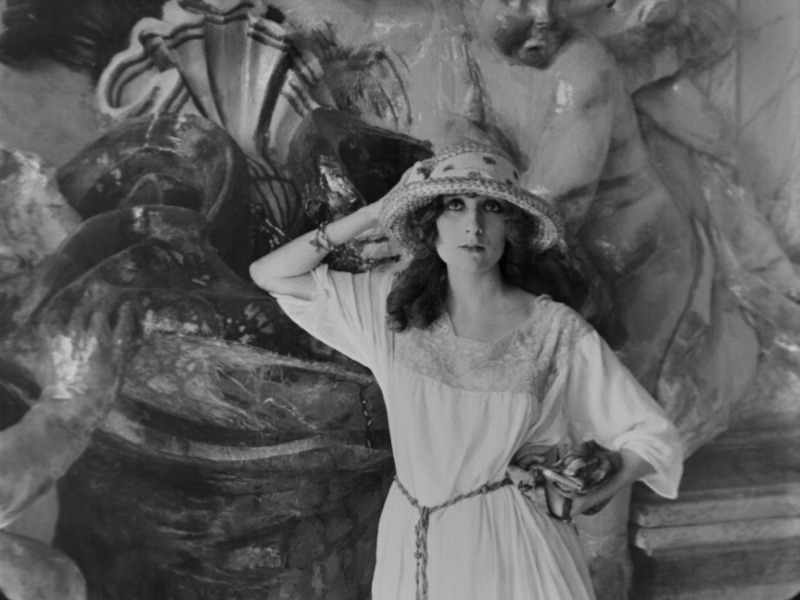IL FAUNO DI MARMO
Mario Bonnard (IT 1920)
In 1917 Mario Bonnard joined his talents as actor to those of director on his first film behind the camera, General-Megale Film’s Treno di lusso, although that film’s withdrawal by the censors meant that his second film as director, Electa Film’s L’altro io, received more attention. These early experiences already point to his interest in literary subjects, while testifying to a refined taste for complex, psychologically acute stories. Il fauno di marmo, one of the last productions of Celio Film, Rome (by then part of the Unione Cinematografica Italiana), is no exception.
The film, a swirling drama of love and death, is loosely adapted from Nathaniel Hawthorne’s 1860 novel The Marble Faun. Princess Maria (Elena Sangro) is married to the Duke of Helgoland (Ugo Bazzini), the leader of an anti-government plot about to be exposed by their house guest Count Giorgio (Carlo Gualandri). Giorgio tries to involve Maria, and in his fatal fight with Helgoland, her husband is killed using the knife that Maria hands to Giorgio. Forced to flee, they meet up again in Rome, where Maria has changed her name to Myriam and Giorgio has become a monk. Giorgio still desires Myriam, who rejects his advances, and she convinces her suitor Donatello (Giorgio Fini) to kill him. I won’t reveal all the ensuing twists and turns of the complicated plot….
Elena Sangro was one of Gabriele D’Annunzio’s muses and already the star of two key works in Italian film history, Fabiola and La Gerusalemme liberata, both directed by Enrico Guazzoni in 1918. Critical reception of Il fauno di marmo was mixed; while the public was enthusiastic, praising “the original and romantic subject handled in a fascinating manner, elegantly staged and superbly acted,” some members of the press complained, “Nothing new and little that’s commendable, either for the subject or the interpretation.” However, Turin’s Cinema Ambrosio, one of the most prestigious movie theatres in the city, reported six days of packed houses between 13 and 19 September 1920 (La Stampa, 16.09.1920). Newspapers enthusiastically pointed out the unprecedented scenes shot on location in Rome, “the adored city of artists worldwide.” Even the publicity made note of this: “for the first, and possibly only time, whole scenes were shot in the Catacombs of S. Domitilla, in the Capitoline Museums, among the ruins of the Colosseum and even in St. Peter’s Basilica.” (L’Arte Cinegrafica, no. 10, 1919) Certainly the play of interiors and exteriors is like a perfect urban and architectural parallel to the complex labyrinthine relationships of the protagonists.
Marcello Seregni
Notwithstanding the very poor Wikipedia entry on the novel, Nathaniel Hawthorne’s The Marble Faun was one of the most influential books for English and American tourists coming to Italy in the 19th century. A work of overriding symbolism rich in descriptive passages, the novel was so widely read that tourists sought out the places frequented by the characters, and travel guides to Rome, like S. Russell Forbes’ Rambles in Rome (1882), listed “Hilda’s Tower” (known in Italy as the Torre della Scimmia) as a destination. Bonnard’s film adaptation – still the only one made – makes significant changes to the plot, eliminating Miriam’s half-Jewish, potentially incestuous origins and opening with an elaborate backstory in which she’s turned into Maria, “princess of Jutland,” who becomes “Myriam” halfway through the narrative. Though the sole surviving print is incomplete, we can see that Bonnard takes advantage of Hawthorne’s Roman settings, including Hilda’s Tower and the famous scene set at the Tarpeian Rock in the Forum, though the addition of Viterbo as a location is only found in the film.
Jay Weissberg


regia/dir: Mario Bonnard.
sogg: dal romanzo di/from the novel by Nathaniel Hawthorne (The Marble Faun, 1860).
photog: Alessandro Bona.
cast: Elena Sangro (S.A.R. la principessa Maria dello Jutland/H.R.H. Princess Maria; Myriam), Elsa D’Auro (Hilda), Carlo Gualandri (Giorgio; il frate/the monk), Giorgio Fini (Donatello), Fernando Ribacchi (Kenyon), Ugo Bazzini (il duca di/Duke of Helgoland), Carlos A. Troisi, Angelo Gallina, Cav. Giuseppe Piemontesi, Giulio Bagnini.
prod: Celio Film, Rome.
v.c/censor date: 01.03.1920.
copia/copy: DCP, 68′ (da/from 35mm, orig. 1785 m.); did./titles: ITA.
fonte/source: Fondazione CSC – Cineteca Nazionale, Roma.




